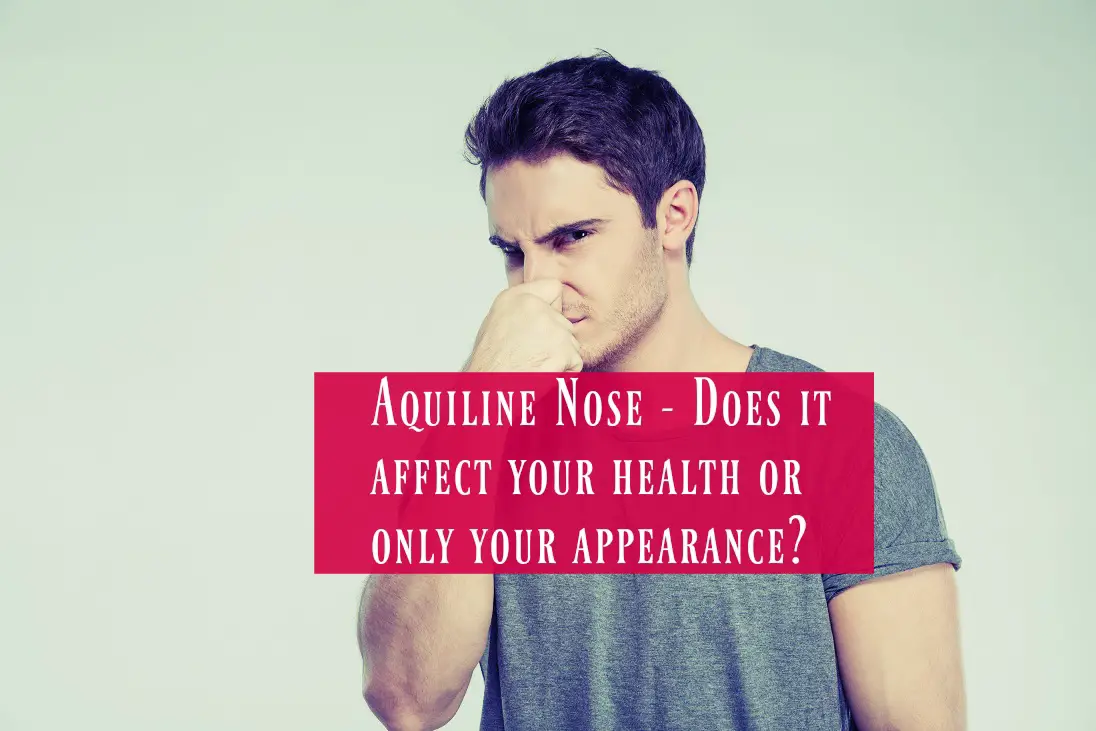The way you see yourself is not just about internal factors.
The way you look and the way you want to look don’t always line up, which can affect your self-esteem.
One feature that is prominent and impactful is the shape of the nose.
Some people have an aquiline nose, which is also called a “Roman” nose.
This nose shape may fit well with your face, but it doesn’t mean it’s the nose you want to see every day. Not only that, the shape of the nose may sometimes have an impact on your health.
Understanding your nose shape and whether it impacts your health can help you decide whether you need to make changes to your nose shape.
What is an aquiline nose?
An aquiline nose is another way to refer to a “Roman” nose.
Sometimes this is also called a “hooked nose” or a “Jewish nose.” Calling the aquiline nose “hooked” or “Jewish” is typically taken as derogatory. As a result, people usually refer to the nose as “Roman” or aquiline.
The shape comes from the prominence of the nasal bridge, which is the bone and cartilage that connects the tip of the nose to the face.
The prominent nasal bridge gives the nose the appearance of being bent or curved.
The name for the nose shape comes from the Latin for “eagle” (aquilinus) because the nose looks similar to the shape of an eagle’s beak.
There is no feature unique to the aquiline nose other than the prominence of the nasal bridge, which gives the curved or bent appearance.
The aquiline nose is not any different from other noses other than the shape being unique.
However, there is a wide range of nose shapes that can be found throughout the human race. As a result, it does not signify a problem or anomaly in the person with that nose shape.
Despite this conclusion, many people consider the aquiline nose as having a defect of the nasal bridge.
Medically, this is referred to as the dorsal subunit.
When someone seeks rhinoplasty, the change in the nose focuses on this part of the nose to eliminate the prominence of the nasal bridge and reduce the “curve” of the nose.
Where does it come from?

Despite the reference to Romans, the aquiline nose can be found in populations all over the world and is not associated with a specific geographic region or population group.
That being said, it is more likely to be found among people from:
- the Balkans
- Central Asia
- South Asia
- Southern Europe
- the Caucasus
- North Africa
- the Horn of Africa and
- the Middle East
Because of the prominence in these populations, it is often associated with being from members of the Oriental race and the Mediterranean people, among others.
Though it can be found all over the world, there is prominence in these areas of the globe, suggesting that the aquiline nose originated in these regions and has since spread across the globe as nations explored, immigrated and intermingled throughout history.
As with other physical characteristics that make up the way a person looks, the aquiline nose is the result of the combined genes from a person’s biological mother and biological father.
The dominance of the genes in the parents determines the extent of the curve in the person’s nose.
This nose shape is simply something that a person is born with.
It may look like a parent’s nose or it may be different from everyone else’s nose in their family lines. In either scenario, the shape of the nose is directly related to the genetics given to the person by his or her biological parents.
How does it affect your health?
Overall, the aquiline nose doesn’t have a substantial impact on a person’s health.
The prominence of the nasal bridge is an aesthetic defect but is not considered a medical defect.
However, the shape of the nose is an element of evolution.
Because of that, the geographic region that led to the nose shape can have an impact on the way the nose works in the body. This can, indirectly, impact a person’s health.
The aquiline nose is more closely associated with people in warmer climates, such as Africa and the Middle East.
These noses do not work the way noses evolved in cold, dry climates did, according to an article from Scientific American. Those noses work to heat and add moisture to the air brought into the nose the way other nose shapes do.
The heat and humidity of the air brought into the nose help ensure that the cilia in the nasal passages work properly to prevent pathogens from entering the body.
In noses that evolved in warm, humid climates, there is less of a need for the air to be warmed and moistened when a person inhales.
As a result,
people who have an aquiline nose may be more susceptible to respiratory problems if they live in cold, dry climates.
Quite simply, their noses do not have the evolutionary features needed to combat the pathogens in the cold air.
What can you do?

The aquiline nose can be changed, if desired.
A person may not have a choice about what his or her nose looks like at birth, but medical science allows changes to be made later.
Since it is not representative of a medical defect, it is typically not changed based on medical necessity.
An exception would be if the shape of the nose is causing respiratory problems, such as in the case of a deviated septum. Instead, if people want their noses changed, it would be through rhinoplasty, which is the plastic surgery of the nose.
If a person decides to pursue plastic surgery to change the nose, it would be done by reducing the prominence of the dorsal.
This would be done by changing the shape of the cartilage and bone under the skin on the bridge of the nose. Both the bone and cartilage would be shaved where they protrude, which causes the prominence of the nasal bridge.
The surgeon would shave the bone and cartilage little by little until the bridge of the nose achieved the right angle.
A surgeon may also decide to narrow and lift the tip of the nose so it looks more natural with the change in the bridge of the nose.
This will give a more attractive finished product for the person seeking rhinoplasty.
It will also help prevent the tip of the nose from dipping when the person smiles. The tip of the nose can dip when smiling after plastic surgery due to the changes in the structure of the nose and the way the muscles work in the face.
When should you see a doctor?
Overall, the shape of your nose shouldn’t cause any health problems.
Any problems you experience would be indirect. For example, you might be more susceptible to respiratory infections because your nose does not adapt well to cold, dry climates.
But, even if your nose shape shouldn’t contribute to health problems, there are signs that you may need to seek medical advice.
If you have trouble breathing or are experiencing frequent respiratory problems, it would be helpful to seek medical advice.
You won’t know if your problems are caused by the shape of your nose unless a medical professional does an examination.
If your nose shape is causing problems, such as difficulty breathing, a medical professional will make recommendations to fix the problem.
This may involve changing the shape of your nose.
More often, people will seek medical advice because they want to change the shape of their aquiline noses for aesthetic reasons.
They may be embarrassed by the prominence of the nasal bridge or they may simply want a different nose shape to be happy with their appearances. If that describes you, a plastic surgeon can provide advice about changing the shape of your nose to meet your aesthetic needs.
What do scientific studies say?
Few, if any, scientific studies have been conducted about aquiline noses.
Research focus on folklore and cultural beliefs rather than the science behind the nose shape. For example, many cultures perceived the aquiline nose as being a sign of nobility or of a strong warrior.
It should be emphasized that this focuses on the aesthetic characteristics of the nose instead of medical components.
Additional research may provide additional insights into the impacts of the evolution of the nose on people’s health.
This can help people better understand the way their bodies work and how their bodies impact their health.
In conclusion
Even though you may not like the shape of your aquiline nose, it typically doesn’t have an impact on your health.
However, if it does, you can seek medical advice to determine whether surgery is needed to change the shape of your nose.
Whether you decide to have surgery or not, seek medical advice if you:
- are prone to respiratory illnesses
- have trouble breathing
- snore frequently
Leave Feedback: Was this article helpful?

